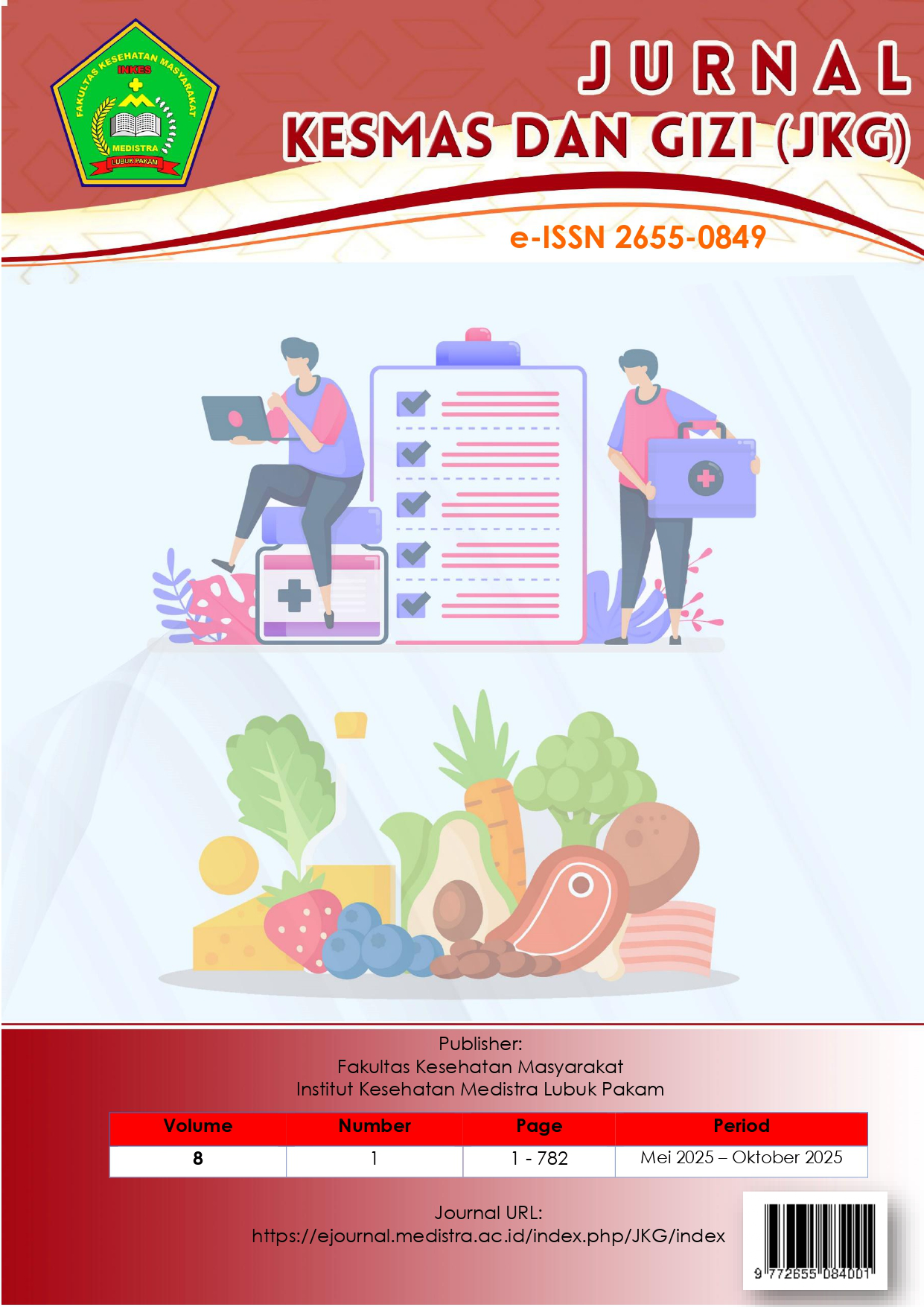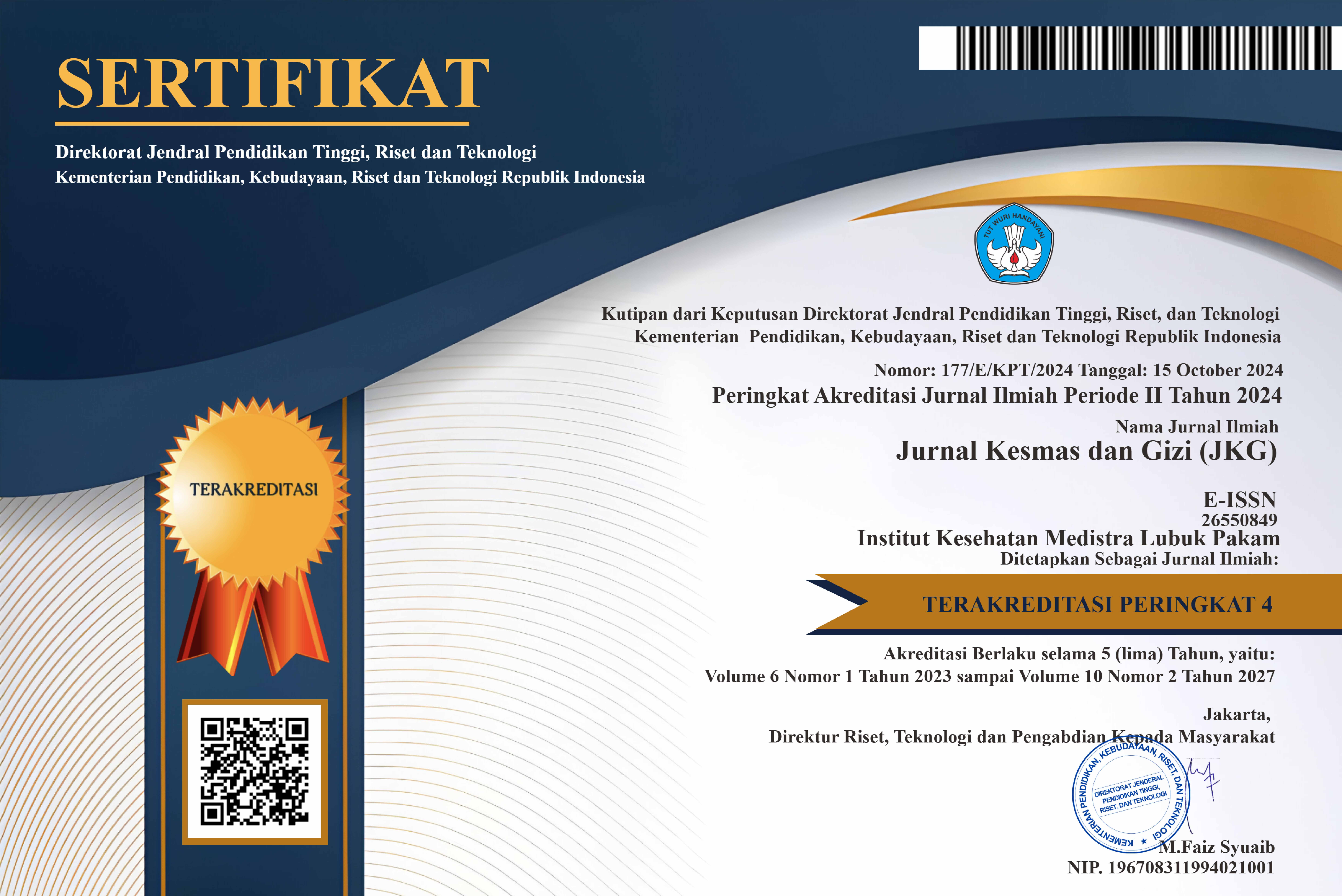Factors Affecting the Quality of Life of the Elderly in the Working Area of Medan Denai Public Health Center in 2025
DOI:
https://doi.org/10.35451/z5dqds18Keywords:
Quality of Life, ElderlyAbstract
The aging process results in muscle weakness, physical decline, and various degenerative diseases. These factors significantly affect the quality of life of the elderly, as they reduce independence and force them to rely on others for assistance. This study aimed to analyze the factors affecting the quality of life of the elderly in the working area of the Medan Denai Public Health Center in 2025. A quantitative research approach with a descriptive correlational design was used. The research was conducted from July 2024 to January 2025 at the Medan Denai Health Center. The sample consisted of 143 elderly individuals selected through accidental sampling, specifically those who visited the health center for treatment or consultation. The results showed a significant relationship between quality of life and several variables: gender (p = 0.001), marital status (p = 0.000), income (p = 0.005), stress (p = 0.005), social interaction (p = 0.007), and family support (p = 0.001). The most dominant factor influencing the quality of life was family support. Therefore, it is recommended that the elderly receive sufficient support to remain active and independent in their daily activities. Social interaction with peers should be encouraged to prevent loneliness, which could lead to stress. Furthermore, providing educational support and involving retired or non-working elderly in light, non-competitive, and deadline-free tasks can enhance their sense of productivity and usefulness within the family. Health centers are encouraged to continue supporting the elderly and to conduct family education programs to promote independence and activity among elderly individuals in their daily routines
Downloads
References
[1] B. S. Panjaitan, “Hubungan Dukungan Keluarga dengan Kualitas Hidup Lansia,” *J. Keperawatan*, vol. 2, no. 2, pp. 35–43, 2020.
[2] Badan Pusat Statistik Provinsi Sumatera Utara, “April 2023: Ekspor Sumatera Utara Mengalami Penurunan 23,33%,” 2022. [Online]. Available: https://sumut.bps.go.id/pressrelease/2023/06/05/982/april-2023--ekspor-sumatera-utara-mengalami-penurunan--sebesar-23-33-persen.html
[3] Rizaty, “Data Sebaran Penduduk Lansia di Indonesia Pada 2023,” 2024. [Online]. Available: https://dataindonesia.id/varia/detail/data-sebaran-persentase-penduduk-lansia-di-indonesia-pada-2023
[4] Rusmayanti, “Hubungan Keluarga dengan Tingkat Kemandirian Dalam Melakukan Self Care Pada Pasien Stroke di RSUD Kota Yogyakarta,” *Hosp.*, vol. 87, no. 1–2, pp. 149–200, 2017.
[5] H. Sabila, “Langkah Mudah Manajemen Stres pada Lansia,” 2022. [Online]. Available: https://www.geriatri.id/artikel/1265/langkah-mudah-manajemen-stres-pada-lansia
[6] I. Indrayogi, A. Priyono, and P. Asyisya, “Peningkatan Kualitas Hidup Lansia Melalui Pemberdayaan Lansia Produktif, Gaya Hidup Sehat Dan Aktif,” *Indones. Community Serv. Empowerment J. (IComSE)*, vol. 3, no. 1, pp. 185–191, 2022.
[7] Mongdong et al., “Faktor-Faktor yang Berhubungan dengan Kualitas Hidup Lansia di Kelurahan Kakaskasen,” *J. Dharma Medika*, vol. 2, no. 1, 2023.
[8] Wahyuni et al., “Gambaran Interaksi Sosial Lansia di Masyarakat Kecamatan Payung Sekaki Kota Pekanbaru,” *JOM Perpustakaan Fak. Keperawatan*, vol. 7, no. 1, pp. 119–125, 2020.
[9] W. T. Widodo, “Hubungan antara Interaksi Sosial dengan Tingkat Depresi Pada Lansia di Panti Tresna Wherda Khusnul Khotimah Pekanbaru,” 2022. [Online]. Available: http://repository.uin-suska.ac.id./59389/
[10] A. Ariyanto, N. Puspitasari, and D. N. Utami, “Aktivitas Fisik Terhadap Kualitas Hidup Pada Lansia,” *Kesehat. Al-Irsyad*, vol. XIII, no. 2, pp. 145–151, 2020.
[11] W. Andriyani, Sudirman, and S. M. Yuniarsih, “Faktor-Faktor Yang Berhubungan Dengan Kemandirian Lansia Dalam Melakukan Activity Daily Living,” *Nurs. Sci. J.*, vol. 4, no. 2, pp. 15–30, 2020.
[12] Anugrah, “Kualitas Hidup Lansia di Era Teknologi Tentukan Capaian Indonesia Emas Tahun 2045,” 2023. [Online]. Available: https://www.ui.ac.id/kualitas-hidup-lansia-di-era-teknologi-tentukan-capaian-indonesia-emas-2045/
[13] Sugiyono, Metode Penelitian Kuantitatif, Kualitatif dan R&D, Bandung: Alfabeta, 2011.
[14] N. P. Supraba and T. R. Permata, "Hubungan Tingkat Kemandirian dengan Kualitas Hidup Lanjut Usia di Wilayah Kerja Puskesmas Kelapa Kabupaten Bangka Barat," J. Kesehatan Poltekkes Kemenkes RI Pangkalpinang, vol. 9, no. 1, pp. 42–49, 2021.
[15] Wahyuni et al., "Gambaran Interaksi Sosial Lansia di Masyarakat Kecamatan Payung Sekaki Kota Pekanbaru," J. Online Mahasiswa Perpustakaan Fak. Keperawatan, vol. 7, no. 1, pp. 119–125, 2020.
[16] W. T. Widodo, "Hubungan antara Interaksi Sosial dengan Tingkat Depresi Pada Lansia di Panti Tresna Wherda Khusnul Khotimah Pekanbaru," 2022. [Online]. Available: http://repository.uin-suska.ac.id./59389/
[17] R. Y. Wildhan, R. V. Suryadinata, and I. B. M. Artadana, "Hubungan Tingkat Activity Daily Living (ADL) dan Kualitas Hidup Lansia di Magetan," J. Ilm. Kedokteran Wijaya Kusuma, vol. 11, no. 1, pp. 42–48, 2022.
[18] World Health Organization, The World Health Organization Quality of Life (WHOQOL) BREF. 2004. [Online]. Available: https://www.who.int/substance_abuse/research.../english_whoqol.pdf. [Accessed: Feb. 10, 2024].
[19] World Health Organization, World Report on Ageing and Health. Geneva: WHO Press, 2021.
[20] J. B. Sinuraya, "Faktor-faktor yang berhubungan dengan rendahnya kunjungan lansia pada program Posyandu Lansia di Puskesmas Padang Bulan," Jurnal Kesehatan. Masyarakat & Gizi, vol. 2, no. 1, Mei–Okt. 2019. [Online]. Tersedia: ejournal.medistra.ac.id/index.php/JKG
Downloads
Published
Issue
Section
License
Copyright (c) 2025 Yosphine Sol Siegal, Taruli R Sinaga, Jasmen Manurung, Donal Nababan, Henny Arwina Bangun

This work is licensed under a Creative Commons Attribution 4.0 International License.
Copyright in each article is the property of the Author.


























